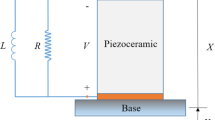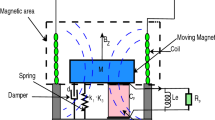Abstract
Combining the complex factors of mechanical impact, Coulomb friction, harmonic excitation, and Gaussian white noise, an electromagnetic energy harvesting system is analytically studied. Based on stochastic averaging, Fokker–Planck–Kolmogorov equation of the probability density function (pdf) and backward Kolmogorov equation of the conditional reliability function are analytically derived. Solutions are correspondingly calculated by means of finite difference method. Numerical results are shown simultaneously for the purpose of verifying the effectiveness of such a semi-analytical procedure. Effects of the system coefficients on the pdfs, conditional reliability function, mean first passage time, and mean square electric current are discussed. It is found that the relation between energy harvesting performance and reliability should be balanced instead of ignoring the influence on system reliability while pursuing the increase of output electric current by tuning the system coefficients.












Similar content being viewed by others
Data Availability
The datasets generated during and/or analyzed during the current study are available from the corresponding author on reasonable request.
References
Mokhtari, F., Foroughi, J., Zheng, T., Cheng, Z., Spinks, G.M.: Triaxial braided piezo fiber energy harvesters for self-powered wearable technologies. J. Mater. Chem. A 7(14), 8245–8257 (2019). https://doi.org/10.1039/c8ta10964h
Abdelmageed, M.G., El-Bab, A.M.F., Abouelsoud, A.: Design and simulation of pulsatile blood flow energy harvester for powering medical devices. Microelectron. J. 86, 105–113 (2019). https://doi.org/10.1016/j.mejo.2019.02.021
Zhou, X., Liu, G., Han, B., Liu, X.: Different kinds of energy harvesters from human activities. Int. J. Energy Res. 45(4), 4841–4870 (2021). https://doi.org/10.1002/er.6045
Lai, Z., Wang, S., Zhu, L., Zhang, G., Wang, J., Yang, K., Yurchenko, D.: A hybrid piezo-dielectric wind energy harvester for high-performance vortex-induced vibration energy harvesting. Mech. Syst. Signal Process. 150, 107212 (2021). https://doi.org/10.1016/j.ymssp.2020.107212
Yang, K., Abdelkefi, A., Li, X., Mao, Y., Dai, L., Wang, J.: Stochastic analysis of a galloping-random wind energy harvesting performance on a buoy platform. Energy Convers. Manage. 238, 114174 (2021). https://doi.org/10.1016/j.enconman.2021.114174
Yuen, K.V., Xu, L.: Efficiency enhancement of electromagnetic energy harvesters for high-rise buildings. Struct. Control Health Monit. 28(6), 2722 (2021). https://doi.org/10.1002/stc.2722
Taghavifar, H.: A novel energy harvesting approach for hybrid electromagnetic-based suspension system of off-road vehicles considering terrain deformability. Mech. Syst. Signal Process. 146, 106988 (2021). https://doi.org/10.1016/j.ymssp.2020.106988
Pan, H., Qi, L., Zhang, Z., Yan, J.: Kinetic energy harvesting technologies for applications in land transportation: a comprehensive review. Appl. Energy 286, 116518 (2021). https://doi.org/10.1016/j.apenergy.2021.116518
Kim, S.H., Thakre, A., Patil, D.R., Park, S.H., Listyawan, T.A., Park, N., Hwang, G.-T., Jang, J., Kim, K.-H., Ryu, J.: Enhancement of energy-harvesting performance of magneto-mechano-electric generators through optimization of the interfacial layer. ACS Appl. Mater. Interfaces 13(17), 19983–19991 (2021). https://doi.org/10.1021/acsami.1c00922
Yu, T., Zhou, S.: Performance investigations of nonlinear piezoelectric energy harvesters with a resonant circuit under white gaussian noises. Nonlinear Dyn. 103(1), 183–196 (2021). https://doi.org/10.1007/s11071-020-06170-9
He, Q., Daqaq, M.F.: Electric load optimization of a nonlinear mono-stable duffing harvester excited by white noise. Meccanica 51(5), 1027–1039 (2016). https://doi.org/10.1007/s11012-015-0289-7
Petromichelakis, I., Psaros, A.F., Kougioumtzoglou, I.A.: Stochastic response determination and optimization of a class of nonlinear electromechanical energy harvesters: a wiener path integral approach. Probab. Eng. Mech. 53, 116–125 (2018). https://doi.org/10.1016/j.probengmech.2018.06.004
Sengha, G., Kenfack, W.F., Siewe, M.S., Tabi, C.B., Kofané, T.C.: Dynamics of a non-smooth type hybrid energy harvester with nonlinear magnetic coupling. Commun. Nonlinear Sci. Numer. Simul. 90, 105364 (2020). https://doi.org/10.1016/j.cnsns.2020.105364
Huang, D., Chen, J., Zhou, S., Fang, X., Li, W.: Response regimes of nonlinear energy harvesters with a resistor-inductor resonant circuit by complexification-averaging method. Sci. China Technol. Sci. 64(6), 1212–1227 (2021). https://doi.org/10.1007/s11431-020-1780-x
Sun, Y., Yang, Y., Zhang, Y., Xu, W.: Probabilistic response of a fractional-order hybrid vibration energy harvester driven by random excitation. Chaos 31(1), 013111 (2021). https://doi.org/10.1063/1.5145178
Qian, F., Zhou, S., Zuo, L.: Approximate solutions and their stability of a broadband piezoelectric energy harvester with a tunable potential function. Commun. Nonlinear Sci. Numer. Simul. 80, 104984 (2020). https://doi.org/10.1016/j.cnsns.2019.104984
Tran, N., Ghayesh, M.H., Arjomandi, M.: Ambient vibration energy harvesters: a review on nonlinear techniques for performance enhancement. Int. J. Eng. Sci. 127, 162–185 (2018). https://doi.org/10.1016/j.ijengsci.2018.02.003
Ahmad, M.M., Khan, N.M., Khan, F.U.: Review of frequency up-conversion vibration energy harvesters using impact and plucking mechanism. Int. J. Energy Res. (2021). https://doi.org/10.1002/er.6832
Halim, M.A., Park, J.Y.: Theoretical modeling and analysis of mechanical impact driven and frequency up-converted piezoelectric energy harvester for low-frequency and wide-bandwidth operation. Sens. Actuator A Phys. 208(2), 56–65 (2014). https://doi.org/10.1016/j.sna.2013.12.033
Gu, L., Livermore, C.: Impact-driven, frequency up-converting coupled vibration energy harvesting device for low frequency operation. Smart Mater. Struct. 20(4), 045004 (2011). https://doi.org/10.1088/0964-1726/20/4/045004
Jacquelin, E., Adhikari, S., Friswell, M.I.: A piezoelectric device for impact energy harvesting. Smart Mater. Struct. 20(10), 105008 (2011). https://doi.org/10.1088/0964-1726/20/10/105008
Le, C.P., Halvorsen, E.: Mems electrostatic energy harvesters with end-stop effects. J. Micromech. Microeng. 22(7), 74013–74024 (2012). https://doi.org/10.1088/0960-1317/22/7/074013
Cottone, F., Vocca, H., Gammaitoni, L.: Nonlinear energy harvesting. Phys. Rev. Lett. 102(8), 080601 (2009). https://doi.org/10.1103/PhysRevLett.102.080601
Lan, C., Qin, W.: Vibration energy harvesting from a piezoelectric bistable system with two symmetric stops. Acta Phys. Sin. Ch. Ed. 64, 210501 (2015). https://doi.org/10.7498/aps.64.210501
Zhou, S., Cao, J., Inman, D.J., Liu, S., Wang, W., Lin, J.: Impact-induced high-energy orbits of nonlinear energy harvesters. Appl. Phys. Lett. 106(9), 093901 (2015). https://doi.org/10.1063/1.4913606
Haroun, A., Yamada, I., et al.: Study of electromagnetic vibration energy harvesting with free/impact motion for low frequency operation. J. Sound Vib. 349, 389–402 (2015). https://doi.org/10.1016/j.jsv.2015.03.048
Green, P., Worden, K., Sims, N.: On the identification and modelling of friction in a randomly excited energy harvester. J. Sound Vib. 332(19), 4696–4708 (2013). https://doi.org/10.1016/j.jsv.2013.04.024
He, X., Teh, K.S., Li, S., Dong, L., Jiang, S.: Modeling and experimental verification of an impact-based piezoelectric vibration energy harvester with a rolling proof mass. Sens. Actuator A Phys. 259, 171–179 (2017). https://doi.org/10.1016/j.sna.2017.03.034
Fu, Y., Ouyang, H., Davis, R.B.: Nonlinear dynamics and triboelectric energy harvesting from a three-degree-of-freedom vibro-impact oscillator. Nonlinear Dyn. 92(4), 1985–2004 (2018). https://doi.org/10.1007/s11071-018-4176-3
Fu, Y., Ouyang, H., Davis, R.B.: Effects of electrical properties on vibrations via electromechanical coupling in triboelectric energy harvesting. J. Phys. D Appl. Phys. 53(21), 215501 (2020). https://doi.org/10.1088/1361-6463/ab7792
Lu, Y., Juillard, J., Cottone, F., Galayko, D., Basset, P.: An impact-coupled mems electrostatic kinetic energy harvester and its predictive model taking nonlinear air damping effect into account. J. Microelectromech. Syst. 27(6), 1041–1053 (2018). https://doi.org/10.1109/JMEMS.2018.2876353
Su, M., Xu, W., Yang, G.: Stochastic response and stability of system with friction and a rigid barrier. Mech. Syst. Signal Process. 132, 748–761 (2019). https://doi.org/10.1016/j.ymssp.2019.07.018
Kumar, P., Narayanan, S.: Chaos and bifurcation analysis of stochastically excited discontinuous nonlinear oscillators. Nonlinear Dyn. 102(2), 927–950 (2020). https://doi.org/10.1007/s11071-020-05960-5
Liu, L., Xu, W., Yue, X., Qiao, Y.: Reliability of elastic impact system with coulomb friction excited by gaussian white noise. Chaos Soliton Fract. 131, 109513 (2020). https://doi.org/10.1016/j.chaos.2019.109513
Dai, Q., Harne, R.L.: Charging power optimization for nonlinear vibration energy harvesting systems subjected to arbitrary, persistent base excitations. Smart Mater. Struct. 27(1), 015011 (2017). https://doi.org/10.1088/1361-665X/aa9a13
Friswell, M.I., Bilgen, O., Ali, S.F., Litak, G., Adhikari, S.: The effect of noise on the response of a vertical cantilever beam energy harvester. ZAMM Z. Angew. Math. Mech. 95(5), 433–443 (2015). https://doi.org/10.1002/zamm.201300183
Fezeu, G., Fokou, I.M., Buckjohn, C.N.D., Siewe, M.S., Tchawoua, C.: Resistance induced p-bifurcation and ghost-stochastic resonance of a hybrid energy harvester under colored noise. Physica A 557, 124857 (2020). https://doi.org/10.1016/j.physa.2020.124857
Zhang, Y., Jin, Y., Li, Y.: Enhanced energy harvesting using time-delayed feedback control from random rotational environment. Physica D 422, 132908 (2021). https://doi.org/10.1016/j.physd.2021.132908
Wu, Y., Luo, M., Zhu, W.: First-passage failure of strongly nonlinear oscillators under combined harmonic and real noise excitations. Arch. Appl. Mech. 78(7), 501–515 (2008). https://doi.org/10.1007/s00419-007-0174-5
Renaud, M., Fujita, T., Goedbloed, M., de Nooijer, C., van Schaijk, R.: Improved mechanical reliability of mems electret based vibration energy harvesters for automotive applications. In: Journal of Physics: Conference Series, vol. 557, p. 012071. IOP Publishing (2014). https://doi.org/10.1088/1742-6596/557/1/012071
Zhou, Q., Kim, J.N., Han, K.W., Oh, S.W., Umrao, S., Chae, E.J., Oh, I.: Integrated dielectric-electrode layer for triboelectric nanogenerator based on cu nanowire-mesh hybrid electrode. Nano Energy 59, 120–128 (2019). https://doi.org/10.1016/j.nanoen.2019.02.022
Tsujiura, Y., Suwa, E., Kurokawa, F., Hida, H., Kanno, I.: Reliability of vibration energy harvesters of metal-based PZT thin films. In: Journal of Physics: Conference Series, vol. 557, p. 012096, IOP Publishing (2014). https://doi.org/10.1088/1742-6596/557/1/012096
Eshghi, A.T., Lee, S., Sadoughi, M.K., Hu, C., Kim, Y.C., Seo, J.H.: Design optimization under uncertainty and speed variability for a piezoelectric energy harvester powering a tire pressure monitoring sensor. Smart Mater. Struct. 26(10), 105037 (2017). https://doi.org/10.1088/1361-665X/aa8886
Zhang, J., Gao, L., Xiao, M.: A new hybrid reliability-based design optimization method under random and interval uncertainties. Int. J. Numer. Methods Eng. 121(19), 4435–4457 (2020). https://doi.org/10.1002/nme.6440
Seong, S., Hu, C., Lee, S.: Design under uncertainty for reliable power generation of piezoelectric energy harvester. J. Intell. Mater. Syst. Struct. 28(17), 2437–2449 (2017). https://doi.org/10.1177/1045389X17689945
Zhu, W., Cai, G.: Introduction to Stochastic Dynamics. Science Press, Beijing (2017)
Huang, Z., Zhu, W., Suzuki, Y.: Stochastic averaging of strongly non-linear oscillators under combined harmonic and white-noise excitations. J. Sound Vib. 238(2), 233–256 (2000)
Zhu, W., Cai, G.: Stochastic Vibration. Science Press, Beijing (1998)
Jin, X., Wang, Y., Chen, M.Z., Huang, Z.: Response analysis of dielectric elastomer spherical membrane to harmonic voltage and random pressure. Smart Mater. Struct. 26(3), 035063 (2017). https://doi.org/10.1088/1361-665X/aa5e44
Xu, M., Wang, Y., Jin, X., Huang, Z., Yu, T.: Random response of vibro-impact systems with inelastic contact. Int. J. Non-linear Mech. 52, 26–31 (2013)
Luan, X., Wang, Y., Jin, X., Huang, Z.: Response evaluation and optimal control for stochastically excited vibro-impact system with hertzdamp contact. J. Vib. Eng. Technol. 7(1), 83–90 (2019)
Feng, J., Che, G., Nie, Y.: Principle of Numerical Analysis. Science Press, Beijing (2001)
Huang, Z., Zhang, L.: Stationary solutions of high dimensional reduced FPK equation using both finite difference method and successive over-relaxation method. Chin. J. Comput. Mech. 25(2), 177–182 (2008). https://doi.org/1007-4708(2008)02-0177-06
Zhu, W., Wu, Y.: First-passage time of duffing oscillator under combined harmonic and white-noise excitations. Nonlinear Dyn. 32(3), 291–305 (2003). https://doi.org/10.1023/A:1024414020813
Acknowledgements
This work is supported by the National Natural Science Foundation of China (Grant Nos. 12072261, 12172286, and 11872305).
Funding
Funding was provided by National Natural Science Foundation of China (Grand Nos. 12072261, 12172286 and 11872305).
Author information
Authors and Affiliations
Corresponding authors
Ethics declarations
Competing interests
The authors declare this manuscript is original and they have no potential competing interests with respected to the research, authorship, and publication of this article.
Additional information
Publisher's Note
Springer Nature remains neutral with regard to jurisdictional claims in published maps and institutional affiliations.
Appendices
Appendix A
The implicit finite difference approximation to Eq. 36 is
where
And \(\Delta H, \Delta \Gamma \) are discrete steps of variables H and \(\Gamma \), respectively. Boundary conditions are \({p_{M + 1,j}} = {p_{1,j}},{p_{0,j}} = {p_{M,j}},{p_{i,0}} = {p_{i,1}},{p_{i,N}} = 0\). Substituting Eq. 48 into Eq. 36 and letting \(\partial p/\partial t=0\), the stationary joint pdf \(p(H,\Gamma )\) can be obtained by means of finite difference method and successive over relaxation method [52, 53].
Appendix B
The implicit finite difference equations to Eqs. 39 and 47 are
respectively, where
\(\Delta t\) is the time step, \(\Delta H_0, \Delta \Gamma _0\) are discrete steps of variables \(H_0\) and \(\Gamma _0\), respectively. Boundary conditions for Eq. 49 are \(R_{M + 1,j}^{n + 1} = R_{1,j}^{n + 1},R_{0,j}^{n + 1} = R_{M,j}^{n + 1},R_{i,0}^{n + 1} = R_{i,1}^{n + 1},R_{i,N}^{n + 1} = 0\), and for Eq. 50 are \({\mu _{M + 1,j}} = {\mu _{1,j}},{\mu _{0,j}} = {\mu _{M,j}},{\mu _{i,0}} = {\mu _{i,1}},{\mu _{i,N}} = 0\).
Rights and permissions
About this article
Cite this article
Su, M., Wei, W., Xu, W. et al. Stochastic response and reliability of electromagnetic energy harvester with mechanical impact and Coulomb friction. Nonlinear Dyn 109, 2263–2280 (2022). https://doi.org/10.1007/s11071-022-07596-z
Received:
Accepted:
Published:
Issue Date:
DOI: https://doi.org/10.1007/s11071-022-07596-z




